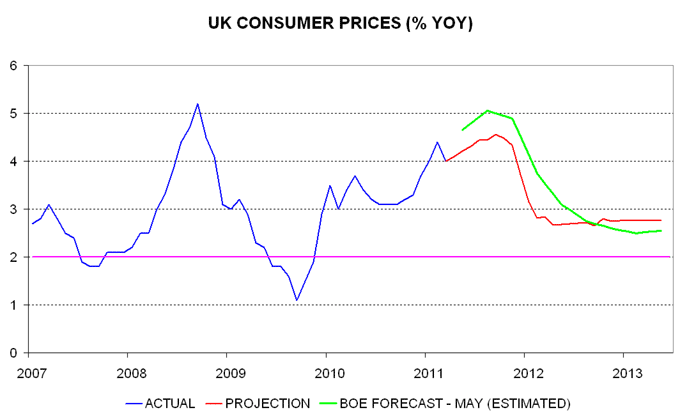Is the BoE now too pessimistic about near-term inflation?
The chart shows an update of a monthly CPI inflation profile presented in a previous post together with the Bank of England's mean forecast based on unchanged policy, estimated from chart 5.13 of the May Inflation Report. Assumptions underlying the profile include:
-
"Core" prices – defined here as the CPI excluding unprocessed food and energy – rise at a 2.25-2.5% annualised rate, in line with an estimate of the trend leading into the recent VAT hike.
-
90% of the VAT rise has been passed onto consumers, consistent with evidence from the Bank of England agents' survey – higher pass-through implies a larger mechanical fall in inflation next year as the impact drops out.
-
Household energy bills rise by 7.5% over the next 12 months.
-
Unprocessed food inflation peaks at an annual 6% in mid 2011 and slows to 3.5% in 2012.
-
Bank rate is raised to 2% next year, contributing to core inflation remaining stable despite a further rise in capacity utilisation as the recovery continues.
-
Undergraduate tuition fees add 0.2 percentage points to inflation from late 2012, as discussed in a previous post.
On these assumptions, inflation is projected to peak at 4.6% later this year before falling back below 3% in early 2012. The average between April 2011 and June 2012 is 0.6 percentage points lower than in the Bank's forecast, showing a quarterly peak of more than 5%. The profile, however, is higher from late 2012, with inflation stabilising at about 2.75% versus the Bank's 2.5%.
Reasons for these differences include:
-
The Bank's forecast incorporates a larger rise in household energy bills, of about 12.5% rather than 7.5%. The latter takes account of the recent correction in wholesale energy prices and assumes that slower emerging-world growth will relieve upward pressure over the remainder of 2011.
-
The Bank assumes lower VAT pass-through of about 75% rather than 90%, despite the evidence from its own agents, resulting in a smaller favourable base effect on inflation in 2012.
-
The Bank's lower forecast from late 2012 reflects its view that spare capacity remains significant and will bear down on core inflation, despite limited evidence of such an impact to date. The Bank's medium-term numbers would be closer to 2% if based on the assumption of a rise in Bank rate to 2% in 2012.
While inflation is likely to remain well above the target for the foreseeable future, a significant fall next year should contribute – with rising wage growth and employment – to a rebound in household real income, in turn supporting prospects for consumer spending and GDP expansion.


Reader Comments